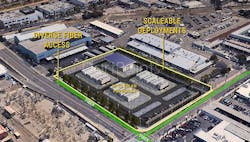Digital Infrastructure’s OpEx Shift: The Case for Renting vs Buying
The sheer volume of decisions to make and factors to consider can become overwhelming. Much like deciding whether to rent an apartment or buy your own home, corporate leaders must determine whether it makes sense for their operation to invest in on-premises data storage (CapEx), go with a private or hybrid cloud solution through a service provider (OpEx), or store their own digital infrastructure off-premises in a hosted environment (a combination of the two.)
CapEx – or capital expense – refers to investing in upfront costs such as real estate, equipment, and physical infrastructure. These are items that remain on the company books but will depreciate over time. An on-prem data center is the most CapEx-intensive because it requires the company to pay for all servers and other equipment, as well as ongoing fees such as maintenance, power, and cooling. Think of this model as home ownership.
OpEx – or operational expense – are costs that come directly out of the company’s monthly operational expense budget, similar to paying monthly rent on an apartment.
When enterprises are making tough decisions about IT budget, the question of how much to allocate toward CapEx vs OpEx is an important one. We are seeing a shift toward OpEx models for companies across verticals, largely because it is becoming less and less feasible for enterprises to effectively manage their own data centers in-house — in fact, according to a recent Credit Suisse CIO survey, 76% of CIOs either plan to deploy into colocation/wholesale data centers and over half expect to shutdown enterprise-owned data centers going forward.
Here are several elements companies must consider when determining which option is best for their specific requirements.
Up-Front Costs
With a CapEx approach to data storage, the entire sum of the assets must be paid on the front end (though ongoing fees will also likely apply). An on-prem approach requires the organization to obtain everything for the data center, including real estate and equipment. These assets, which include storage and backup infrastructure, server hardware, software licensing, and network infrastructure, are certainly expensive, and they must be in place by day one.
With the OpEx model, the company utilizes their provider’s facility and often their equipment and is responsible for monthly payments based on capacity and services. Additionally, with OpEx, there are no overhead or installations costs, and organizations only pay for the space, power, and resources they need.
Day-to-Day Operations
Under the CapEx model, most of a company’s resources are deployed on-premises, while an OpEx approach means the customer stores their data in a third-party location. While some organizations might worry about a perceived loss of control with an off-premises solution, most companies appreciate having a dedicated and qualified team of IT professionals managing their data, so their employees can focus on core business objectives.
Ongoing Maintenance
It is inevitable that assets such as equipment and real estate will depreciate over time. Because of this, much of it will need to be replaced, or will require heavy maintenance, every three to five years. However, these cycles are not always predictable, which means companies that have invested in full ownership often face unanticipated expenses that surface at the least convenient times. With OpEx, equipment and server maintenance and management are handled and paid for by the service provider.
Scalability
Data center scalability is necessary to support increasing IT demands, and infrastructure needs can change quickly. Companies that operate their own data centers might not have the necessary real estate or resources to accommodate fast growth. For this reason, a CapEx approach is not ideal for companies where speed of scale is a priority. Scaling down is also not easy in a CapEx model if the need for data center capacity decreases. Organizations that own their own data centers will be stuck with unnecessary space and equipment, which negatively impacts the overall ROI.
Scaling is much simpler and cost effective under the OpEx model. When growth is necessary, the infrastructure is already in place, so the provider has the ability and resources to scale up as quickly as possible to keep up with increasing needs and specifications — additionally, if needs decrease, you only pay for the capacity you actually use.
Upgrading
A company that invests in owning its own hardware is stuck with that equipment once they buy it. That means that when upgrades and new IT tools become available, the company must pay heavily to upgrade or replace what they have already purchased, in order to take advantage of the latest equipment on the market. With OpEx, a good service provider makes continuous updates to their (and your) network and systems as new features are released. This means companies have ongoing access to the latest technology without any added expense.
Stepping Back
It is up to corporate leaders to determine which data storage solution is right for their organization. Many leaders have realized that hybrid cloud and colocation solutions offer far more advantages, such as fewer – or at least more predictable – costs, easier scalability, and the most important of all features: more time and energy to focus on your core business. By outsourcing data center infrastructure and management, they are keeping their focus on business growth, customer experience and employee retention, instead of staying distracted by data center management. Strategically outsourcing to trusted partners is one way many enterprises are staying ahead of competition.
With OpEx solutions, companies only pay for the space, power, and equipment they need. Factors such as upgrades, maintenance and IT staffing are managed by the provider, and scaling to meet fluctuating business requirements is simple and cost-effective.
The best data storage option depends on each organization’s unique business needs, budget, and resource availability. Newer companies can select the right infrastructure solution to deploy from the beginning and should consider each of these factors when making that decision. Established organizations with older IT infrastructure will eventually need to decide whether to transition to a new model or invest in their current solution.
Scott Willis is DartPoints’ President and Chief Executive Officer and also serves as a member of the Board of Directors. Whether you want to co-locate your own data center equipment, integrate physical infrastructure with the cloud, or step into a fully managed IT solution, contact DartPoints to learn more about their data storage solutions.





